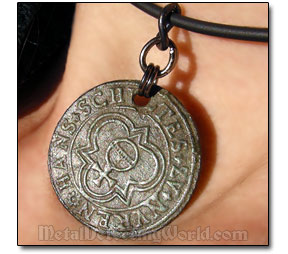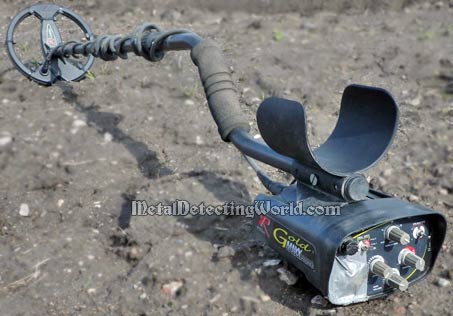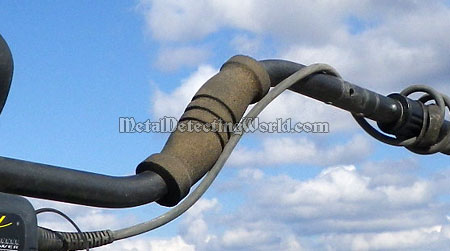XP GoldMaxx Power Metal Detector
Flaws in Poor Design Are Compensated by Great Performance, or Can Be Fixed, page 1

Since the XP GoldMaxx Power (GMP) was released into the market in 2005, it has earned a reputation of the most effective machine for reviving the "searched-out" sites and detecting a lot of valuables at such sites where other metal detectors, including the reputable FBS models, are just "quiet". I bought the GoldMaxx Power for my girlfriend Irina in 2010, and she immediately began finding coins and artifacts at the "hunted-out" locations.
Her first find with the GMP was this Merchant Jetton of Hans Schultes III in Nuremberg, Germany, circa 1608-1612. Because jettons of this type are thin-sectioned and made of brass, it is hard to find one in excellent condition even though such jettons are not considered rare finds in our search area.

Irina was fortunate to find an exceptionally well-preserved jetton which had an obverse inscription: "GLICK KVMPT VON GOT ISTWAR" - "Truly, Good Fortune Comes From God". Bearing no high monetary value, the Schultes' jetton had some sentimental value to Irina and, having such an inscription and a readily available hole, rightfully became her lucky metal detecting charm to be worn during our treasure hunting outings! :)
Irina's Lucky Metal Detecting Charm

The high frequency GMP is a turn-on-and-go detector that really does "pick out" the "keepers" from the clusters of iron junk due to high reactivity speed, lack of non-ferrous Discrimination and implementation of two key-features - Iron Volume and Silencer, that make a big difference. The GMP is also a great Relic Hunting machine as it gets good depth on big stuff especially in damp ground. No wonder, this metal detector was a prototype for a legendary Deus. You may want to read my review on the GoldMaxx Power.
Only the GoldMaxx Power's amazing performance at the iron-infested sites compensates for the GMP's poor physical body design. Most of design flaws result from the GMP's "hipmounted-control-box" operational concept. The XP engineers' goal was to make a super light machine to minimize a user's fatigue during long hunts, however, the GMP's 3.4lbs (1.55 kg) in total weight would not be a problem even if the long-hour detecting was conducted with a control box affixed to a stem.
Practically, the detector's hipmounted operation is necessary in cases when the detector is used by an operator with a physical impairment, and if the detector's weight is above 4.5 lbs, and/or a large (18" or larger) search coil is employed for searching vast areas. Otherwise, during target excavation and recovery, the operator's movement is unreasonably restricted by a coil cable connected to the hip mounted control box.
If a user does not like operating the GMP with the control box hipmounted, he/she is left with only three "bummer" options if the S-shaped aluminum stem of early type is used:
1) The worst option is to attach the control box under an arm-rest. First, if you metal detect on muddy surface in the plowed field, the control box would be placed right into the mud every time you lower the detector to the ground

Secondly, the search coil cable runs along the handle (?!). Either you grab the handle along with cable and experience a great deal of discomfort or you keep the cable away from the handle but risk to accidentally catch and damage the cable.

A late model of the GMP incorporates a telescopic stem of the Deus and does not allow for mounting the control box on a middle shaft (above or under). So now the control box can be either affixed under an arm-rest or hip-mounted.
Number of pages: | 1 | 2 | 3 | 4 | 5 | Next >
My Equipment Page | Useful Articles page | Secrets for Beginners | Metal Detector Reviews Worldwide | Home